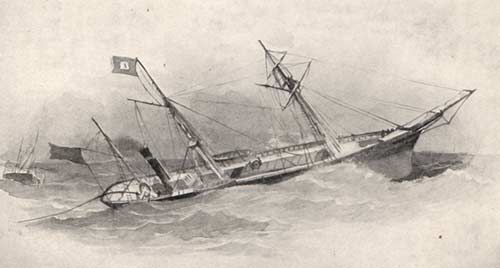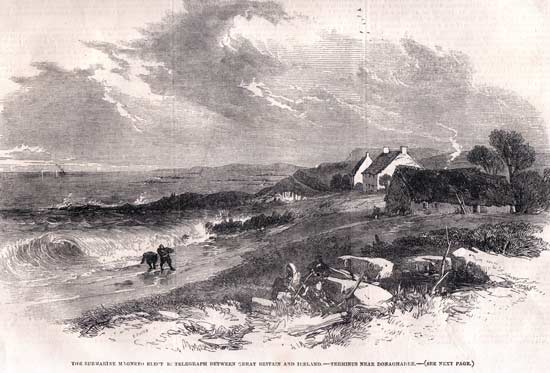|
Portpatrick, Scotland - Donaghadee, Ireland. The Gutta
Percha Company supplied the core and the cable was made by R.S. Newall
& Co for the British &
Irish Magnetic Telegraph Co.
William Hutt laid the 25 nm. cable, which
consisted of six conductors, each a single copper wire of No. 16 BWG covered
with gutta percha to No. 2 BWG and armoured with twelve No. 2 BWG iron
wires. The cable was taken over by the GPO in 1870.
The Mechanic's Magazine, No. 1556 for Saturday, June 4, 1853, reported on the cable expedition as follows:
THE PORTPATRICK AND DONAGHADEE
SUBMARINE TELEGRAPH
This important line of communication has at length been successfully effected by a submarine cable, manufactured by Messrs. Newall and Co., of Gateshead, and laid down by that firm on Monday week between Donaghadee and Portpatrick. The cable consists of six communicating wires, insulated in gutta percha, and protected in the usual manner by an outer covering of iron wire. It could not he laid, as was intended, during the previous week, owing to the gales from the East preventing the opening of the dock gates at Sunderland to let the vessel containing it pass out. As several previous attempts to lay a submarine telegraph across the Irish Channel had failed, every care was taken to insure the successful termination of the present attempt, and the expedition, consisting of the screw-steamer Hutt (with the cable and apparatus on board), the Conqueror, and the Wizard, left the Irish coast, having landed the end of the cable at a point about two miles to the south of Donaghadee harbour, and commenced the submersion of the cable. This operation was performed under the guidance of Captain Hawes, R.N., especially appointed by the Admiralty, who rendered great assistance in determining and directing the exact course to be pursued, without which, in all probability, the squadron could not have successfully overcome the swift tides and adverse currents prevalent throughout in this part of the Channel. The party who accompanied the laying of the cable included, Messrs. Newall, the contractors: Mr. Statham, of the Gutta Percha Works; Mr. Bright, the Secretary; Mr. Charles Bright, the engineer of the English and Irish Magnetic Telegraph Company; Mr. Reid, the telegraph engineer; and Mr. Moseley. The cable was landed on Wednesday morning, in a sandy bay (called Mora-bay), a little to the north of Portpatrick, which belongs to Mr. Blair, of Dunskey, who kindly accorded permission for the laying of the landwire, through his estate; and as soon as the end had been taken up to the position assigned, the instruments were put in operation, and the following message was dispatched:—
“Mora-bay, Portpatrick, Monday, May 23.
“The directors of the English and Irish Magnetic Telegraph Company beg to acquaint his Excellency the Lord Lieutenant that they have this morning successfully effected communication between the shores of Great Britain and Ireland, by means of a submarine cable from Portpatrick to Donaghadee.”
The cable at each side was then buried in the trenches prepared for its reception, and instruments connected to serve as a means of communication for a short time, until the subterranean line of six wires now being carried from the company's station at Carlisle, through Dumfries, to meet the cable at Portpatrick, is completed to that spot; and an underground line is about to be extended from the Irish end of the cable at Donaghadee to Newtownnards, the terminal station of the County Down Railway, along which the wires of the English and Irish Magnetic Telegraph Company are nearly completed to Belfast. At Belfast the wires meet the company's line of telegraph already completed over the Ulster Railway, and will be carried, via the Belfast Junction and Dublin and Drogheda Railways, into the company's offices on College-green, Dublin, where their line from Galway (already working) and their southern line of telegraph, now in forward course of construction from Cork, will concentrate. The lines of the English and Irish Magnetic Telegraph Company now working between Liverpool, Manchester, Bolton, and Preston, and between Glasgow, Greenock, and Edinburgh, and those now in forward progress between London and Manchester (consisting of the subterranean wires), and between Preston and Carlisle, will join on at Carlisle, and the the three capitals and chief towns of England, Scotland, and Ireland, will be thus brought into instantaneous communication with one another. |
This cable was the first laid by Charles Bright in
deep water. His biography, published in 1902, gives this technical description of the cable
laying:
An important improvement
was effected in the design of this cable as compared with what immediately
preceded it. In this case an inner bedding of yarn was supplied for the
six insulated wires (see illustration). The total weight of the cable
was seven tons to the mile. The manufacture was carried out unaccompanied
by any serious mishap. As fast as it was made, it was coiled up on the
wharf ready for shipment. When the time for shipment came, the massive
six-core cable was stowed away in the hold of the laying vessel in an
oblong coil.
It so happened that the
submergence of this line had to take place during the days closely following
upon Charles Bright's marriage. The expedition was graced by the presence
of his bride, who was thus able to assist at the telegraphic union of
Great Britain and Ireland. The expedition consisted of the screw steamer William Hutt (with the cable and apparatus on board), the Conqueror,
and the Wizard. The ships were under the navigation control of
Captain Hawes, R.N., especially appointed by the Admiralty. Beside young
Bright and his bride, there were on board during the expedition:- Mr.
Newall, the contractor; Mr. Statham, of the Gutta-Percha Company; Mr.
William Reid, and Mr. T. B. Moseley.
Starting operations from
the Irish coast, the shore end of the cable was first landed at a point
about two miles from the south of Donaghadee Harbour, Co. Down, and the
laying of the deep-sea cable was then proceeded with. This undertaking
was not, however, without its vicissitudes. The arrangements and apparatus
then employed for submerging a cable were, it need scarcely be said, not
of the complete character with which experience has endowed us to-day.
Each coil was turned bodily over by the men below to take the turn out
in emerging to the guide pulley above, whence it passed through a rotometer,
or speed measurer, to a large drum on deck. Round this drum it took several
turns before passing into the sea over an iron rail at the stern. The
drum was fitted with a flexible iron strap on its circumference, attached
to a lever hand-brake, to check the cable's rate of delivery outboard.
Without this precaution, in the deeper water (nearly a quarter of a mile
in places) the heavy monster would have "taken charge" altogether.
As it was - when a heavyish sea arose about midway across - notwithstanding
the efforts of the man in the hold, one turn got on several occasions
under another, making a "foul flake," which would pass up in
a tangled mass. This necessitated the stopping of the ship and a temporary
cessation of paying-out operations till the great knot was unravelled.
Such an operation as this is no easy matter when the extreme rigidity
of this heavily armoured cable, with its twelve stout iron wires, is considered.

The William Hutt, laying the first
cable to Ireland, 1853 |
Thus it was that the expedition
did not arrive and anchor off Port Patrick, on the southern border of
Wigtownshire, until midnight, the landing of the shore end being deferred
till the following morning. This final operation was performed, amid much
enthusiasm, in Mora Bay, a little to the north of Port Patrick. As soon
as the cable end had been taken up to the position assigned for it, the
signalling apparatus was put into operation, and the following message
despatched to Dublin:-
MORA
BAY, PORT PATRICK,
May 23rd, 1853. |
| The Directors of the British and Irish Magnetic Telegraph Company beg to acquaint His Excellency the Lord Lieutenant that they have this morning successfully effected communication between the shores of Great Britain and Ireland by means of a submarine cable from Port Patrick to Donaghadee. |
The cable lasted, with
slight repairs, for many years - up to, and long after, the purchase of
the Magnetic Company's lines by the Government, in 1870.
In later years, when referring
to this expedition, Sir Charles Bright used to humorously remark that,
so long as we had telegraphic communication with Ireland, there could
be no possible need for discussing the question of Irish Home Rule.
|
Later in the year the Illustrated London News gave an update on the cable in its issue of 27 August 1853:
THE SUBMARINE MAGNETO-ELECTRIC TELEGRAPH
BETWEEN GREAT BRITAIN AND IRELAND
It was once the uncharitable wish of a certain member of the Legislature, that Ireland could be still more removed from the mother country, by driving the Green Isle further out into the Atlantic Ocean. The wish now excites a smile by its oddity; but, it is pleasanter to report that science has of late devised the means of bringing the two countries into instant communication.
Since the afternoon of Sunday, the 22nd May, the Submarine Telegraph has been extended from, the Scotch to the Irish coast, the termini being a point near the harbour of Portpatrick, in Scotland, and a small bay at Templepatrick churchyard, a mile or to the south of Donaghadee, in Ireland. We have engraved the latter terminus.

The Submarine Magneto Electric Telegraph between
Great Britain and Ireland – Terminus near Donaghadee |
This great undertaking has been accomplished by the English and Irish Magneto-Electric Company. It was formerly essayed by another company, but without success: some miles’ length of' the cable, after having been submerged and buoyed, were hauled up by the crew of a little coasting schooner from Larne, who mistook the hempen‑covered wire for hawser, and bore off as much as they could pull up as a treasure trove. The cable, which is now submerged, was manufactured by the eminent firm of Messrs. R.S. Newall and Co., and consists of six strongly‑covered and perfectly insulated wires, wound round a centre of hemp and iron.
The first intercommunication (on May 22) was a message to the Lord Lieutenant of Ireland, and the reply has already been detailed. From this period to the present, the Cable has been most effectively worked, although of course, not being as yet linked with any of the great marts in the empire, it is useless.
The Company are making strenuous efforts to complete that portion of their lines which lie between Portpatrick and Carlisle; and we perceive by the files of the Northern Whig that on the Irish side of the Channel the Magneto Electric Company have entered into contracts for the Dublin and Drogheda Railway, 32 miles; the Navan branch, 19½ miles; the Kells branch, 9¾ miles; the Dublin and Belfast Junction, 56 miles; the Ulster Railway, 25 miles; Portadown to Belfast; and Portadown to Armagh, 11 miles; the County Down Railways to Newtownards and Holywood; the Great Southern and Western; the Kildare and Carlow; the Killarney Branch, &c., &c. They have, also for some months past, had a telegraph in communication between Dublin and Galway. |
|

